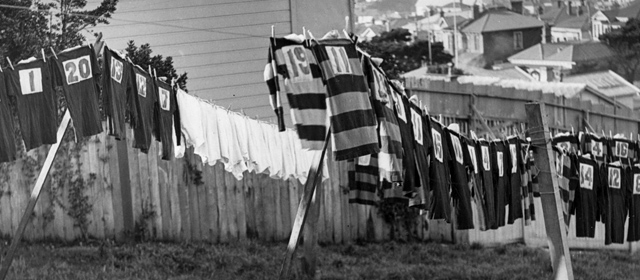Story summary
The arrival of British sport
In the 19th century settlers brought traditional British sports such as cricket, horse racing and rowing. They soon also took up newly organised British games such as rugby and tennis. Sport was encouraged to provide reassuring features of ‘home’, and to create social harmony.
Growth
Following the gold rushes of the 1860s and the immigration schemes of the 1870s, the population grew and sports participation increased – as did the variety of sports on offer.
At first professionalism and gambling played a large part in sporting culture. However, by the late 1860s sports clubs were becoming more firmly established, promoting ideals of amateurism.
Provincial and national coordination
From the 1870s improving transport and communication made it easier for players from main settlements to come together. Provincial organisations were formed, and, before long, national bodies. They began to organise international sporting tours.
Ethnicity and gender
Conflicts between Māori and Pākehā meant that Māori involvement in European sport was not widespread until late in the 19th century.
European women were largely restricted to support roles in sport – it was believed that vigorous exercise would damage their ability to bear and raise children. During the late 19th century this began to change, although at first women were encouraged only in sports that were non-contact, could be pursued out of the public eye and were not associated with masculinity.
Growing participation
In the 20th century increasing numbers of New Zealanders were able to take part in sports. This was due to shorter working hours, greater access to secondary schooling, improved transport networks and more private cars.
City dwellers gained easier access to the outdoors and took up individualistic pursuits such as hunting, mountaineering, skiing and tramping.
Spectatorship
As populations grew and became concentrated in cities and larger towns, sporting organisations generated revenue by charging spectators for admission to competitions.
From the 1920s live radio broadcasts of sport encouraged public interest, and from the 1960s television brought many New Zealanders even closer to top-level events. It also gave a wider audience to previously minor sports such as snooker, basketball and yachting.
Professional sport and gambling
As the 20th century progressed, opposition to gambling and professionalism faded. New Zealand’s Totalisator Agency Board (TAB) opened its doors in 1951. It was the first off-course race betting agency in the world.
Improved international air travel from the 1960s enabled more New Zealand sportspeople to compete professionally overseas. Professional attitudes, as well as new training and coaching methods, gradually filtered back to New Zealand. In 1995 rugby union became the last of the major sports in New Zealand to fully embrace professionalism.
The club role in sending talent to the next level was weakened by increasing professionalism, which brought with it school sports academies, talent identification programmes and scholarship opportunities to overseas universities.
Challenges
After sports became more widely broadcast on television, attendance at games dropped somewhat. There is also evidence that participation declined in favour of sedentary leisure activities such as watching television and films, gaming and using the internet. Nonetheless, in the 21st century sports remained an integral part of New Zealand culture.





